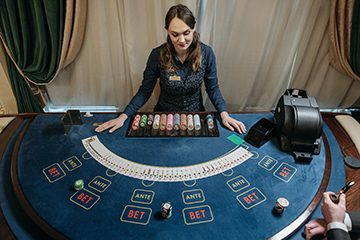
Baccarat is not a game of strategy beyond deciding which bet to make. Whether the banker hand, player hand or both get a third card is played out by rule, with no options for bettors or the dealer. Instead, methods for attacking the game focus on whether to bet banker, player, or, for the adventurous, tie. And they focus on how much to bet.
No hand belongs to any individual bettor. All may wager on the banker hand or the player hand, or make a tie bet. House edges are low on banker (1.06 percent) and player (1.24 percent), but a much-too-high 14.4 percent on ties.
So, should you always bet on the same side? Should you switch back and forth? Can team play work?
The bottom line is that you can’t change the house edge. Nothing you can do moves the math.
But in the short term, just about anything can happen. Here are some methods players use to try to get the most out of baccarat.

Make the Best Bet
The banker bet in baccarat is a rarity in that it wins more often than it loses. Per 1,000 decisions, the banker wins 459 times, the player wins 446 and there are 95 ties. The banker and player don’t lose on the ties, instead, they push and get their money back.
If winning banker bets were paid at even money, like winning player bets, banker bettors would win more money than they lost. Baccarat tables would be crammed with sharpies looking for free money until casinos shut the tables down.
The solution is to charge a 5 percent commission on winning banker bets. If you win a $20 bet on banker, you must pay the house a $1 commission. Your profit on the hand is $19. That is one of the reasons that the minimum bet at many big baccarat tables is $20. The commission comes out in whole dollars. Such tables are stocked with $20 chips, usually yellow and nicknamed “bananas,” that you won’t find anywhere in the casino except at baccarat tables.
The most common minimum bet at mini-baccarat tables on the main casino floor is $10. It’s one thing to stock tables with 50-cent chips for commissions, but another to ask it to go a step further and pay to mint 25-cent chips or tokens, or tie up cash in quarters to make change for a commission at a $5 table.
Some players shy away from banker because of the commission, but it still has the lowest house edge at baccarat and can cut the house edge to the bone if you bet on banker every time.
 Stick with the Winners
Stick with the Winners
Banker is baccarat’s best bet with its 1.06 percent house edge, but player at 1.24 percent also is one of the better bets available in casinos. If you decide to switch back and forth between the two, what method should you use? Many players like to bet on streaks, sticking with one side as long as it wins, more than switching to the other after a loss. A streak bettors’ goal is to ride a long winning streak to big profits. If long streaks don’t come, at least you’re on low house-edge bets all the way. But, obviously, there is no way to tell when a streak is coming. They’re unpredictable. They either happen or they don’t. Not even counting cards helps. This isn’t blackjack, with odds that waver from hand to hand. The odds do change as cards are removed from the usual eight decks used at baccarat, but odds shift so slowly in such small increments that counting is of no practical value. The late Peter Griffin, who was a great mathematician and gambling expert, once calculated that a card counter could gain a 0.7 percent edge on baccarat, but would be for only three hands per eight hours. That’s sitting and waiting, not playing, and isn’t at all practical. So, with betting the streaks, you just have to take your chances.
Sometimes the streaks don’t come, and nearly half the time you’ll be betting on the player. A streak of five banker wins comes only once per 29.76 trials, and a streak of five player wins averages once per 34.47 trials.
When long streaks happen, it means fun and profit. But losses are more frequent, and you have to be prepared for that.
Team Play
This isn’t common, but every so often a reader asks about the possibility of playing as a team to score free comps. The idea is that one partner bets on banker while the other bets on player. One wins while the other loses, cancelling each other out. Meanwhile, both have their wagers track and build rewards credits.
So can zero losses lead to free rooms, meals, shows, airfare, rounds of golf and more? The answer is No. Casinos wouldn’t enable such a ploy. First of all, that pesky commission on banker gets in the way, and if there was no commission, every banker loss would be offset by a player win and every player loss would be offset by a banker win.
Instead, a $20 loss on the player bet is offset only partially by a $19 win on banker bet. For example, if you bet $20 on player and I bet $20 on banker for each of the 1,000 hands with average results, you’d have 13 more losses than wins for a net loss of $260. In my 1,000 hands, I’d bet $20,000, get $20 back on each of 95 ties for $1,900 and get $39 back — my $20 bet plus $19 in winnings — on 459 banker wins for $17,901. That leaves $19,801 on my side of the table for a net loss of $199. So, we don’t break even by betting opposites. We lose $359.
One recent letter from a reader came up with a refinement. What if there were three partners, one betting banker, one betting player and one betting ties. One of three bettors was counting on the 8-1 payoff on ties to bring big profits on hands banker and player both got their money back.
He was counting on the worst bet, with its 14.4 percent house edge, to be the big winner, and that’s not a sharp play. Betting ties increases losses and is not part of any winning scheme.
Progression Betting
Players hoping for a really big win sometimes will increase their bets in winning streaks, hoping one big run will bring big profits. There are many ways to go about this, with some progressions being more aggressive than others. One is the Reverse Martingale, in which players double their bets after any win. If you always double your bets, any loss wipes out all wins, so most players set plateaus. They might follow a $20 win with a $40 bet, and if they win again bet $80, but then wait for a second $80 win before increasing again.
Others modify the progression, so they add less than the full win to the next bet in order to lock up some money. A $20 win might be followed by a $30 bet, then by $40, then $60 and so on.
You might also consider putting a cap on bets and return to your base bet if your winning streak takes you to that cap. If you keep increasing bets without a cap, then any loss will be at your largest wager in the progression.
There are many variations on progressions. Let’s look at one conservative, five-step system.
Using bets on player, a five-step progression might look like this: Bet $20. If you win, bet $20 again, so even if you lose you can do no worse than break even. If you win the second bet, then wager $40, then $60, then $80. After five consecutive wins, roll back to $20 and start over.
If you win all five bets in the conservative progression, you win $220 instead of the $100 you’d win if you bet $20 each time. The downside is that choppy results and early losses can leave you worse off in a progression than with flat bets. If you win two then lose one, you’d win two $20 bets and lose $40 to break even. With no progression, you’d win $20 twice and lose once for a $20 profit. The average result still gives the house a 1.24 percent edge, but results are distributed differently. The progression will give you more large wins when you get a good streak or two, but also more small losses because of the choppy table effect.
Martingale
One of the oldest and longest-used systems in gambling is the Martingale and can be hazardous to your bankroll. Don’t fall into its clutches. In the Martingale, you double bets after every loss and any win will wipe out all losses and leave you with a win equal to your original wager. But, there are problems with it. Bets get very large, very fast. You run into table maximums that make it impossible to double a large bet. Long losing streaks are more likely than players think they are. And regardless of prior results, you are the underdog on every bet.
In this system, if you bet $20 and lose, your next bet is $40. If you lose again, it takes your bet to $80, then $160, $320 and $640. If you win at $640, it offsets $620 in previous losses and gives you a $20 profit.
But, what if the streak goes on and on? After $640, the next bet in the sequence is $1,280, then $2,560. If you get to $2,560, it means you’ve already lost $2,540. Even assuming you haven’t reached the table maximum, do you really want $2,560 on the line to try to turn it into a $20 profit? And remember, you remain the underdog on that bet. In the end, Martingales lead to more small wins than large losses, but when you get stuck with a big losing streak, it’s a bankroll killer.
Most of the systems here are relatively harmless. Better not to include ties in a combination or try team play at all, better not to get too aggressive with progressions, best to stick with the low-edge bets. But avoid Martingales.
By John Growchowski





